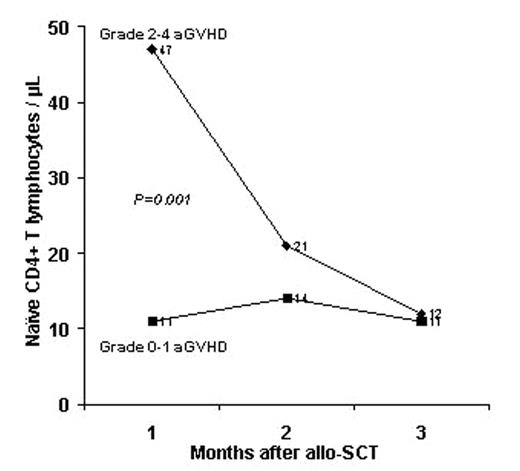Abstract
RIC regimens for allo-CST are being explored with good results concerning feasibility and engraftment. However, little is known about the immune recovery pattern in these patients, especially the different CD4 and CD8 lymphoid T cell subsets. Here, we assessed at different time points after allo-SCT, the kinetic of recovery of naïve (CD45RA+/CD27+), central memory (CD45RA−/CD27+), and terminally differentiated (CD45RA+/CD27−) CD4+ and CD8+ T lymphocytes in 64 patients from a single center, receiving HLA-identical RIC allo-SCT. Patients and graft characteristics are: age 48 y (27–63), diagnoses: 22 myeloid malignancies (34%), 22 lymphoid malignancies (34%) and 20 metastatic solid tumors (31%). 51 pts (80%) were considered as high risk. 49 pts (77%) received a fludarabine, busulfan and ATG-based RIC, while 15 pts (23%) received a low dose irradiation-based RIC. 91% of patients received a PBSC graft, with 42 (66%) receiving CSA alone for GVHD prophylaxis and 22 (34%) receiving CSA and MMF. 24 pts (38%) developed grade 2–4 acute GVHD at a median of 49 d (26–85). In this series, in contrast to CD4+ T cell subsets, CD8+ T cell subsets had a progressive and sustained recovery in the first 3 months after allo-SCT, with acquisition of functional markers such as 2B4 and perforin. Among the different subsets analyzed, the recovery of naïve CD4+ T cells, and central memory CD4+ and CD8+ T cells, measured at day 28 after allo-SCT and before onset of grade 2–4 acute GVHD, showed a significant correlation with the risk of grade 2–4 acute GVHD (P=0.001; P=0.002 and P=0.05 respectively). Patients developing grade 2–4 acute GVHD recovered a median of 47 naïve CD4+ T cells/μL prior to onset of GVHD as compared to 11 cells/μL in patients with grade 0–1 acute GVHD (Figure). Naïve CD4+ T cell levels significantly decreased after appropriate acute GVHD treatment. In a Cox multivariate analysis taking into account all relevant risk factors for acute GVHD, early recovery of naïve CD4+/CD45RA+/CD27+ T cells in the first month after allo-SCT was the strongest parameter significantly predictive of grade 2–4 acute GVHD development (P=0.006; RR=4.0; 95%CI, 1.5–11.0). Interestingly, there was a significant correlation between the total number of CD4+ T cells infused with the allogeneic graft and the early recovery of naïve CD4+ T cells (P=0.001), suggesting that graft manipulation might represent an attractive tool towards harnessing alloreactivity after RIC-allo-SCT.
Author notes
Corresponding author


This feature is available to Subscribers Only
Sign In or Create an Account Close Modal